Types of Steak Cuts
There are so many different types of steak cuts out there, and it’s normal if you only recognize a few popular ones. Each cut has something that makes it stand out, whether it’s the size, tenderness, flavor, marbling, price, or even how it’s butchered.
Below is a detailed list of different cuts of steak available across the United States, categorized by primal cuts.

Rib Primal
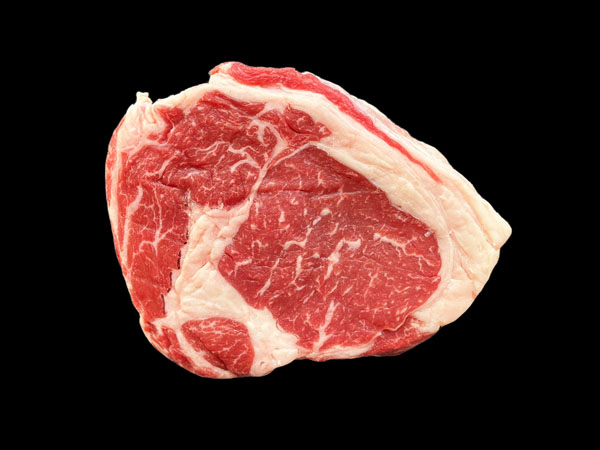
Ribeye Steak
Ribeye steak comes from the rib section of a cow. It’s got a really rich flavor, and it’s super tender. It’s also one of the fattiest cuts, which is why it tastes so good, but that also makes it one of the more expensive options. Regarding cooking, pan-searing is fantastic for bringing out its best. It gives you that awesome crust and keeps the inside juicy. Grilling is cool, too, but watch out for those flare-ups because of all the fat.
Other names: Rib Eye Steak, Rib Steak, Ribeye Roll Steak, Delmonico Steak, Beauty Steak, Spencer, and Market Steak.
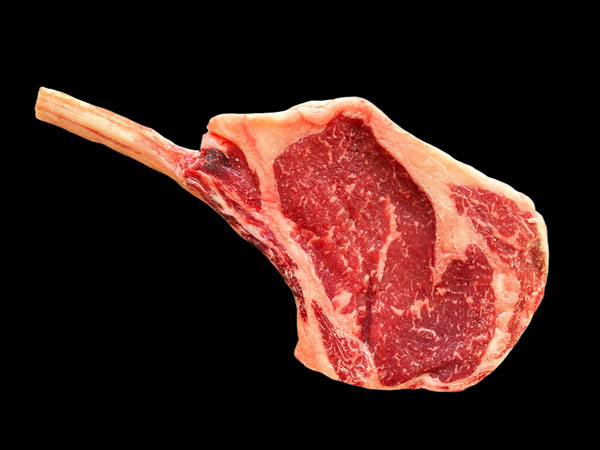
Cowboy Steak
A Cowboy Steak is a ribeye but with a twist. It’s got a bone that is up to 5 inches (13 cm) long. Believe it or not, it tastes just like a boneless ribeye because the bone doesn’t change the flavor. What sets the Cowboy steak apart, though, is that it’s usually a bit thicker than your usual boneless ribeye. Plus, it’s got this cool look, thanks to the slightly longer bone sticking out.
Other names: Bone-In Ribeye (Frenched), Cowboy Cut, Cowboy Rib, Cowboy Ribeye, Frenched Rib Steak.

Tomahawk Steak
Tomahawk steak is a ribeye with a long bone, longer than you see on a cowboy steak. It’s one of the best-looking steaks, and that’s a big reason why it’s popular in steakhouses, especially for special dinners. Tomahawk steak tastes like any other ribeye, but it’s usually a bigger cut, so you must cook it differently. Grilling it with the reverse searing method is the way to go. It cooks the steak evenly and brings out all those great flavors.
Other names: Rib Steak, Bone-In Rib Steak (Frenched).

Bone-In Ribeye Steak
Bone-in ribeye steak (Cote de Boeuf) is a ribeye with the bone still in. Taste-wise, it’s like any boneless ribeye. The only difference is that the bone gives it a different look. Remember that the meat near the bone cooks slower than the rest, but this doesn’t change the overall flavor of the steak. During cooking, the meat shrinks on a pan, so the bone can sometimes prevent the steak from having full contact with the pan surface. Because of that, it’s better to cook the rib steak on a grill if you want to achieve evenly cooked rib steak with a great crust.
Other names: Cote de Boeuf, Rib Steak, Cowgirl Ribeye, Rib Steak Bone-In (Frenched), Bone-In Ribeye.

Ribeye Filet
The ribeye filet is the center muscle of the ribeye steak, known as the eye of the ribeye or longissimus dorsi muscle. It has less external fat than a traditional ribeye but retains much intramuscular fat (marbling), giving it a rich, beefy flavor and tender texture. It’s one of the most flavorful cuts of beef, but unfortunately, it is also one of the most expensive. The best way to cook ribeye filet is by pan-searing or grilling over high heat to get a nice crust on the outside while keeping the inside juicy and flavorful.
Other names: Ribeye Petite Steak, Saratoga Steak, Center-Cut Filet of Ribeye, Smaller Ribeye Steak, Eye of Ribeye, Rib Steak Filet, Beef Filet (from Rib Section), Longissimus Dorsi Filet.

Ribeye Cap Steak
Ribeye cap steak (spinalis dorsi muscle) is one of the tastiest cuts of beef. This muscle, part of the rib section, is carefully trimmed off the ribs as a whole piece before the ribeye steaks are portioned. Known for its rich marbling and incredible tenderness, it offers a luxurious, beefy flavor unmatched by most other steaks. The best way to cook ribeye cap steak is to grill or pan-sear it quickly over high heat. Its flavor shines with minimal seasoning – just salt, pepper, and a bit of butter.
Other names: Ribeye Cap, Spinalis Dorsi, Ribeye Cap Roll, Crown Steak, Butcher’s Butter.

Loin Primal

Tenderloin Steak
Tenderloin steak (filet mignon) comes from the middle of the psoas major muscle in the loin area of the cow. It’s extremely tender but has a mild taste. It’s not just the most tender cut of the cow but also the most expensive. Its luxurious texture and small, lean portions make it a favorite for elegant dinners and special occasions. Best cooked at 1.5 to 2 inches (3.8 to 5 cm) thick, filet mignon shines when pan-seared or grilled to perfection.
Other names: Filet Mignon, Filet, Fillet, Beef Loin, Side Muscle Off, Chateaubriand Filet De Boeuf, Tournedo.

Bone-In Tenderloin Steak
Bone-in tenderloin steak is a rare and luxurious cut, offering the extreme tenderness of a tenderloin steak (filet mignon) with an added aesthetic appeal. The bone doesn’t impact the flavor but does make the steak look stunning. The meat around the bone cooks slightly slower, which can help retain juiciness near the bone. For best results, grill this steak using the reverse searing method – this ensures even cooking and a beautiful crust. While pan-searing is easier, the bone can prevent full contact with the pan, leading to a less impressive crust.
Other names: Filet on the Bone, Bone-in Filet Mignon, Chateaubriand (Bone-In).

Strip Steak
Strip steak (new york strip or kansas city strip), comes from the short loin of a cow. It’s got a great beefy taste and is usually pretty tender, but a lot depends on the steak’s grade and how much marbling it’s got. What’s cool is that a strip steak can be either lean or have more fat, depending on the grade. Strip steak is great for grilling and pan-searing, plus it’s also super easy to cook, which makes it perfect for beginners.
Other names: New York Strip, Kansas City Strip Steak, Strip Loin Steak, Top Loin Steak, Ambassador Steak, Hotel Cut Steak, Hotel-Style Steak, Club Steak, Boneless Club Steak, Veiny Steak, Shell Steak, Delmonico Steak, Strip Steak.
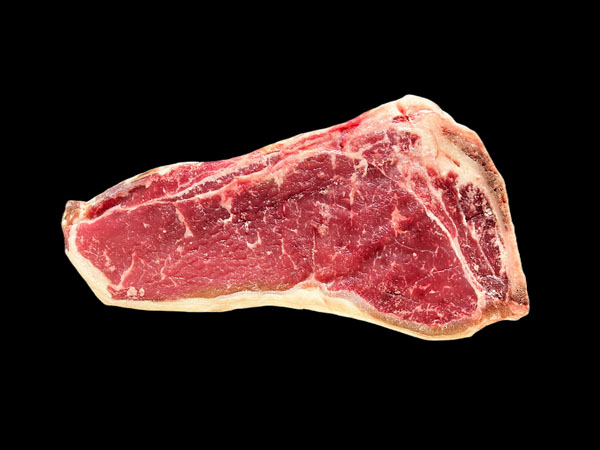
Bone-In Strip Steak
Bone-in strip steak is a strip steak but with the bone still attached. The bone gives it a striking appearance, perfect for an impressive presentation, but it doesn’t change the flavor. Bone-in strip steak shares the same beefy taste and tenderness as a boneless strip steak. The downside is that the bone can make it harder to achieve an even crust since it prevents full contact with the pan. For the best results, grill it using the reverse searing method. This technique ensures even cooking and a beautifully crisp crust.
Other names: New York Strip (Bone-In), Kansas City Strip, Club Steak, Sirloin Strip Steak (Bone-In), Bone-In Striploin Steak.
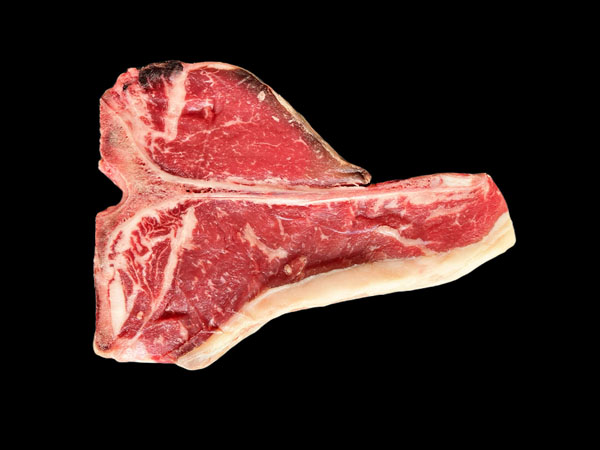
Porterhouse Steak
The porterhouse steak is a two-in-one cut from the rear part of the cow’s short loin primal. Porterhouse steak is like getting two steaks in one. Why two in one? Because you get a filet mignon and a strip steak in one steak. What’s great about the porterhouse steak is how it combines the super tender filet with the rich, beefy taste of the strip. Its impressive appearance on a plate makes it a favorite in steakhouses. Due to its unique shape and bone, cooking it evenly in a pan is tricky. That’s why grilling is the way to go for a porterhouse.
Other names: King Steak, 1st Cut Porterhouse, Porter House.
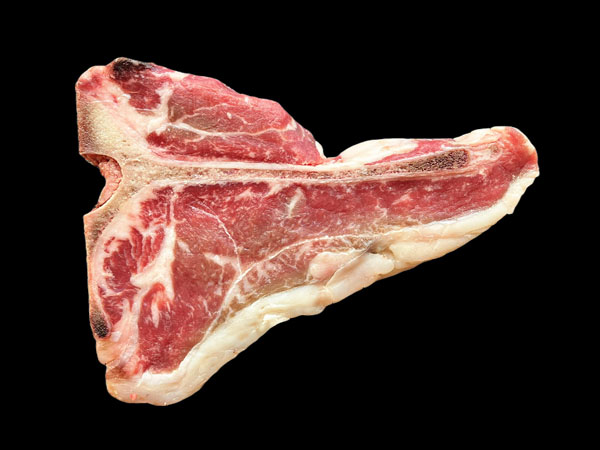
T-Bone Steak
The T-Bone Steak is a two-in-one cut from the front part of the cow’s short loin primal. It’s pretty much like the porterhouse steak. The only difference between them is the width of the filet mignon portion. Since the T-bone comes from the front of the short loin, it ends up with a smaller filet mignon than the porterhouse, which comes from the rear part of the short loin. According to the USDA, the filet mignon part must be less than 1.25 inches (3.175 cm) wide for a steak to be considered a T-bone. If it’s wider than 1.25 inches (3.175 cm), then it’s a porterhouse steak.
Other names: Loin, T-Bone.

Sirloin Primal
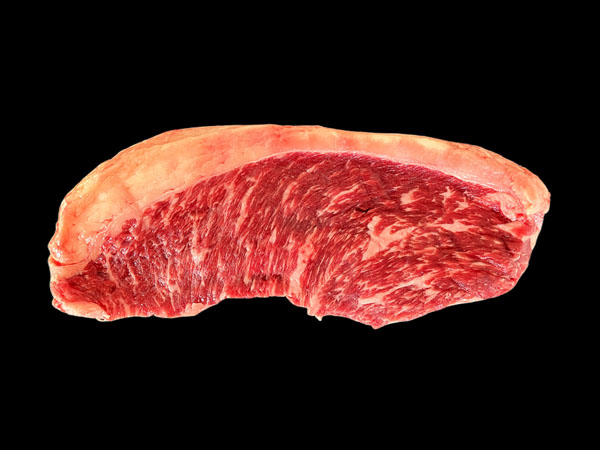
Coulotte Steak
Coulotte steak (picanha steak) comes from the top sirloin butt subprimal in the sirloin primal area of the cow. It’s a favorite in Brazil, known for its rich, beefy flavor and tender texture, especially when sliced against the grain. This cut shines when cooked over an open flame, making it perfect for Brazilian-style churrasco. It’s also great pan-seared, roasted in the oven, cooked sous-vide, or smoked. It’s versatile and delicious no matter how you prepare it. Be sure to sear the fat cap for extra crispiness and flavor.
Other names: Picanha Steak, Top Sirloin Cap Steak, Sirloin Cap.

Tri-Tip Steak
Tri-Tip steak (newport steak) comes from the bottom sirloin part of the cow. It’s a lean cut, but don’t let that fool you – it’s pretty tender if cooked correctly and has a good, strong, beefy flavor. Since it’s not as popular as some other cuts, it’s usually a bit more budget-friendly too. The best way to cook Tri-Tip is to grill or pan-sear it, then slice it against the grain to keep it as tender as possible.
Other names: Newport Steak, Santa Maria Steak, Tri Tip, Triangle Steak.
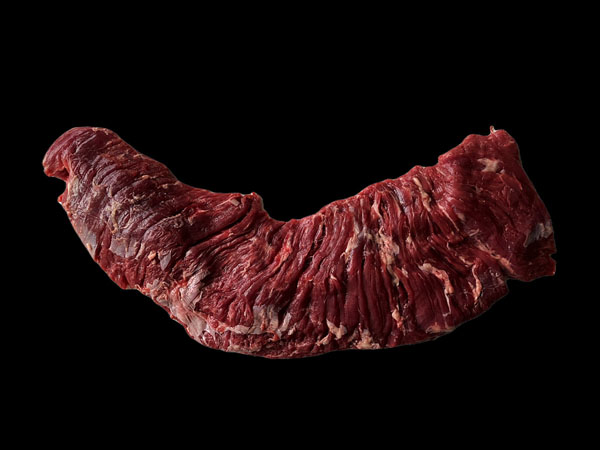
Flap Steak
Flap steak (bavette steak) comes from the bottom sirloin butt. It’s a pretty big cut of beef famous for its beefy flavor, moderate fat content, and quite tender texture if you slice it the right way – against the grain. Since it’s such a long piece of meat, you’ll usually need to cut it into smaller sections for pan cooking. That said, grilling is the best way to cook bavette steak. It just brings out the best in it.
Other names: Bavette Steak, Bottom Sirloin Bavette Steak, Bottom Sirloin Butt, Bottom Sirloin Flap Steak, Bistro Steak, Sirloin Flap Steak, Flap Meat.

Baseball Steak
Baseball steak comes from the center of the top sirloin and gets its name from the way it puffs up into a rounded shape as it cooks. It’s a thick, lean cut with a bold, beefy flavor and a surprisingly tender texture, especially when cooked to medium-rare. Compared to more expensive options like ribeye or filet mignon, it’s a budget-friendly choice for steak lovers. It’s great for grilling or pan-searing, but since it’s lean, it’s important not to overcook it to keep it juicy and tender.
Other names: Center-Cut Top Sirloin Steak, Sirloin Baseball Cut, Baseball Cut Steak, Center-Cut, Boneless Top Sirloin Butt Steak, Top Sirloin Filet, Top Sirloin Butt Steak, Top Sirloin Filet Boneless.

Top Sirloin Steak
Top sirloin steak comes from the top sirloin butt primal, a large cut that includes the picanha (coulotte) and center-cut portions (Center-Cut Top Sirloin and Baseball Steak). It’s a go-to option for home cooks because it’s versatile, affordable, and easy to find. Top sirloin steak is lean and tender, with varying levels of marbling depending on the specific cut part – for example, the coulotte section (picanha) tends to be more marbled than the center-cut sirloin. Though leaner than most premium cuts, it’s still relatively tender and full of beefy flavor. Top sirloin steak is good for grilling and pan-searing. For best results, cook it to no more than medium-rare doneness.
Other names: Boneless Top Sirloin Steak, Top Sirloin Butt Steak, Top Sirloin Steak Boneless Cap Off, Top Sirloin Steak Cap Off, Top Butt Steak.
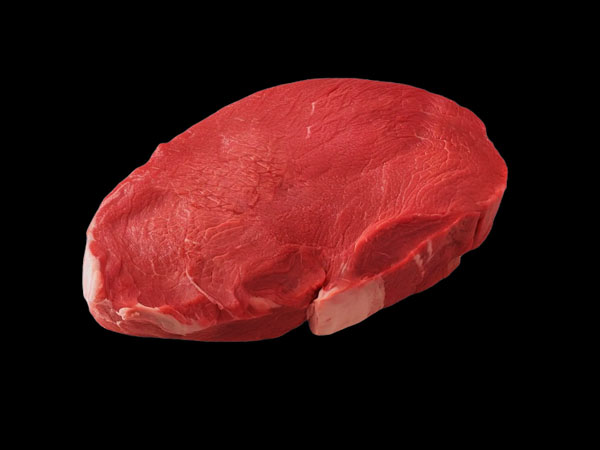
Center-Cut Top Sirloin Steak
The center-cut top sirloin steak comes from the top sirloin butt center, located near the coulotte roast. This cut is larger and leaner than its neighbor, the baseball steak. It has a mild, beefy flavor and is tender when cooked properly. The best way to cook a center-cut top sirloin is by grilling or pan-searing. For the best results, aim for medium-rare doneness to keep it tender and juicy. A simple seasoning of salt and pepper lets its natural flavors shine.
Other names: Center Cut Sirloin, Top Sirloin, Sirloin Steak, Cap Off, Center Sirloin Steak, Sirloin Butt Steak.
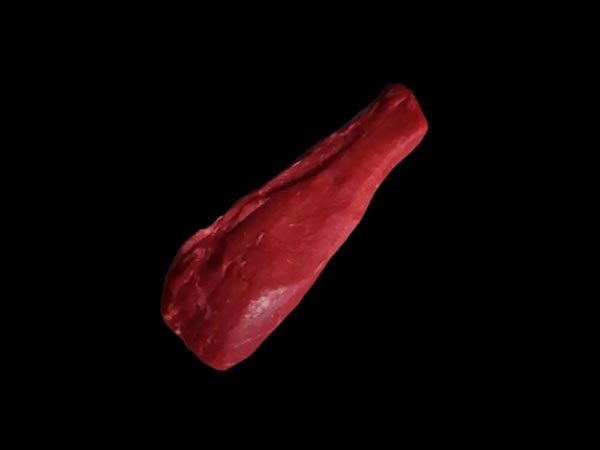
Mouse Steak
Mouse steak is a small, lean cut from the top sirloin butt. It’s a lesser-known steak with a firm texture and beefy flavor. Because it’s lean, it’s an excellent choice for those looking for a healthier steak option. Mouse steak shines when cooked to medium-rare, remaining moderately tender and juicy. The best way to cook it is by pan-searing or grilling over high heat to get a decent crust.
Other names: Mouse Muscle, Sirloin Muscle, Top Sirloin Butt Mouse Muscle, Sirloin Mouse Steak.

Petite Sirloin Steak
Petite sirloin steak comes from the bottom sirloin butt, specifically the ball tip muscle. It’s a lean cut, which makes it a healthier option, and while it’s not as tender as a ribeye or even strip, it still has a nice, satisfying, beefy flavor. Its affordability and compact size make it a favorite for casual meals. The best way to cook petite sirloin steak is by grilling or pan-searing to medium-rare doneness.
Other names: Ball Tip Steak, Sirloin Steak, Sirloin Tip Steak, Kunckle Steak.

Chuck Primal
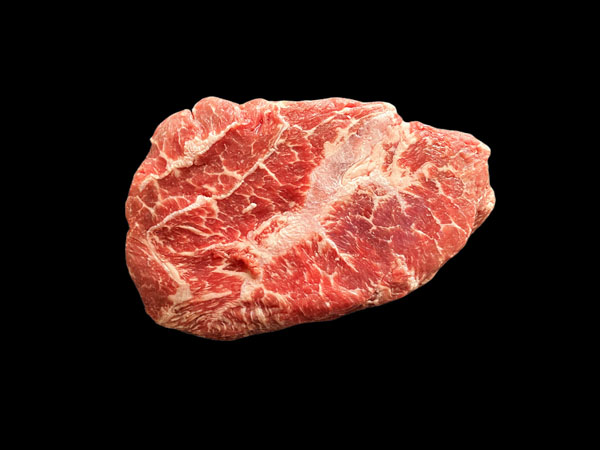
Top Blade Steak
Top blade steak comes from the chuck primal, right from the shoulder top blade roast. It’s got a great beefy taste and a very tender texture. It’s the same muscle you find in flat iron steak, but here’s the thing – they’re butchered differently. The top blade has this big, tough sinew right in the middle that runs through the entire cut. Meanwhile, the flat iron steak doesn’t have that sinew, making it a better choice.
Other names: Boneless Top Chuck Steak, Book Steak, Butler Steak, Charcoal Steak, Oyster Blade Steak, Petite Steak.
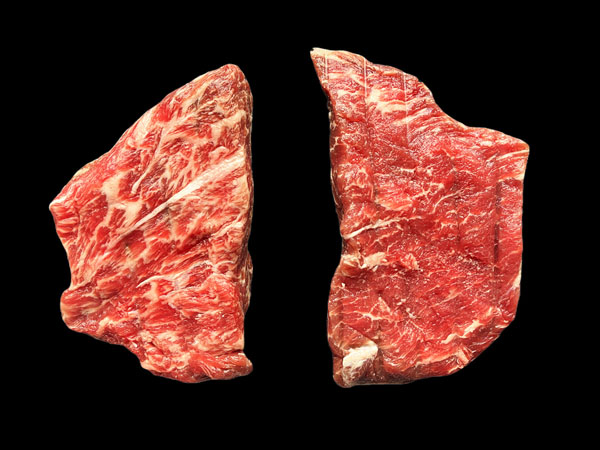
Flat Iron Steak
Flat iron steak comes from the shoulder of the cow, specifically from the chuck primal. Flat iron steak is a part of the top blade roast, which sits right above the shoulder blade. This steak is very tender and has a great beefy flavor. Flat iron steak is one of the most tender cuts of steak you can find. What’s cool about it is that it stays tender and juicy even if you cook it to medium doneness or more. Plus, flat iron steak is awesome for pan-searing and grilling.
Other names: Boneless Top Chuck Steak, Book Steak, Butler Steak.
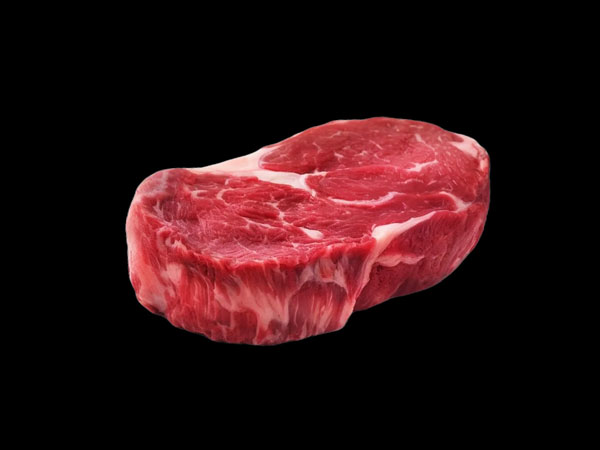
Chuck Eye Steak
Chuck Eye Steak is a flavorful and tender cut with plenty of marbling. It’s a hidden gem for steak lovers on a budget. It’s cut from the fifth rib, right next to the ribeye, and shares that rich, beefy flavor and juicy and tender texture. While it’s not quite as tender as a typical ribeye, it still has a bold, rich taste and comes at a much friendlier price. Perfect for grilling or pan-searing, chuck eye steak shines when cooked medium-rare to medium.
Other names: Boneless Chuck Filet Steak, Delmonico Steak, English Steak, Chuck Delmonico, Poor Man’s Ribeye.
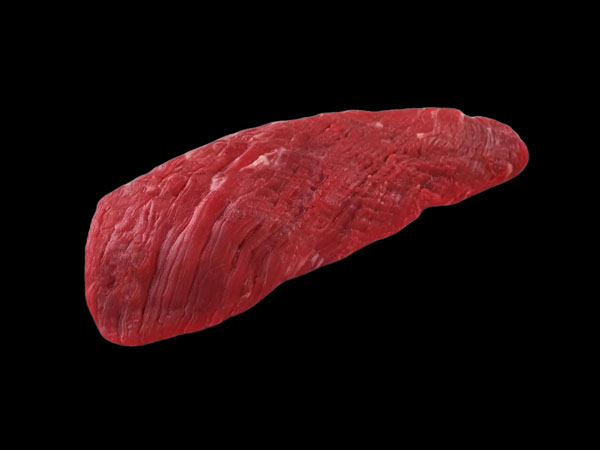
Sierra Steak
Sierra steak is cut from the under blade, a part of the chuck roll subprimal, derived from the chuck primal. Sierra steak has a strong beefy flavor but has a bit tougher texture due to its long, thick, and pronounced muscle grains. Best cooked over high heat, it shines when grilled to medium-rare doneness. For best results, slice sierra steak thinly against the grain after cooking to maximize the tenderness.
Other names: Chuck Flank, Sierra Cut.

Denver Steak
Denver steak comes from the center of the under blade in the chuck primal of the cow. It’s very tender, with a nice amount of marbling that gives it a rich, beefy flavor. Despite being from the chuck, it rivals premium cuts like ribeye or strip steak in texture and taste. While not a widely available cut and slightly more expensive, it’s an excellent choice for a special meal. The best way to cook a denver steak is over high heat on the grill or in a hot skillet.
Other names: Chuck Under Blade Center Steak, Chuck Under Blade Steak, Denver Cut

Ranch Steak
Ranch steak comes from the clod heart roast in the chuck primal of a cow. It’s a lean cut with a strong, beefy flavor but is naturally tough and chewy compared to more tender steaks. Despite this, it’s an affordable choice that rewards careful preparation. To bring out the best out of a ranch steak, marinate it to add tenderness and flavor, then cook it quickly over high heat. Grilling or pan-searing to medium-rare works best. Avoid overcooking to prevent it from becoming overly tough and chewy.
Other names: Arm Steak, Ranch Cut, Shoulder Center Steak, Boneless Chuck Shoulder Center-Cut Steak.

Shoulder Steak
Shoulder steak comes from the shoulder clod of the cow and is a lean, tough cut of beef. It’s usually sliced thinner for steaks and left thicker for roasts. While not naturally tender, shoulder steak boasts a nice, beefy flavor that shines when cooked correctly. Marinate it to help break down the muscle fibers, or try slow-cooking methods like braising to get the best results. It’s not the kind of steak you’d want to throw on a hot grill like a premium cut—it needs a bit more care to bring out its best.
Other names: Arm Steak, English Steak.

Chuck Arm Steak
Chuck arm steak comes from the chuck primal. It’s a large cut containing bones like ribs and consists of several different muscles. Known for its beefy flavor, it’s a tougher cut that needs extra care to make it tender. Marinating is a must to break down the toughness if you plan to cook it as a steak. Alternatively, chuck arm steak is perfect for slow cooking methods like braising or stewing, where low heat and time can transform it into a tender, delicious dish.
Other names: Arm Steak.
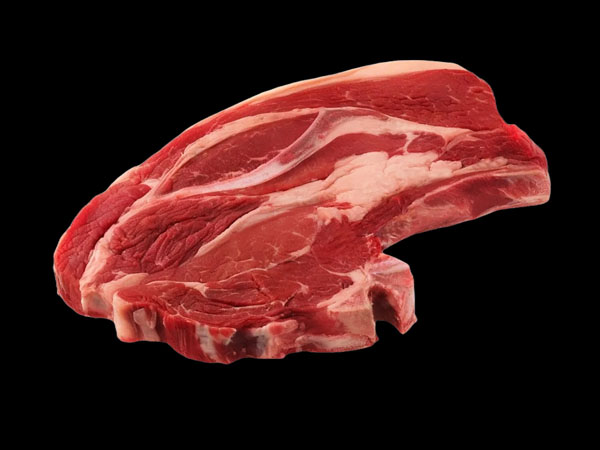
Blade Chuck Steak
Blade chuck steak is a budget-friendly option that comes from the chuck primal. It is a large, bone-in cut made up of several muscles. While it’s known for its beefy taste, it can be tough if not handled properly. Marinating is key to tenderizing the steak. Slow-cooking methods like braising or stewing work best, giving the connective tissue plenty of time to break down. With some patience, blade chuck steak turns into a tender, flavorful dish.
Other names: Boneless Blade Steak 1st Cut, Deluxe Blade Steak.
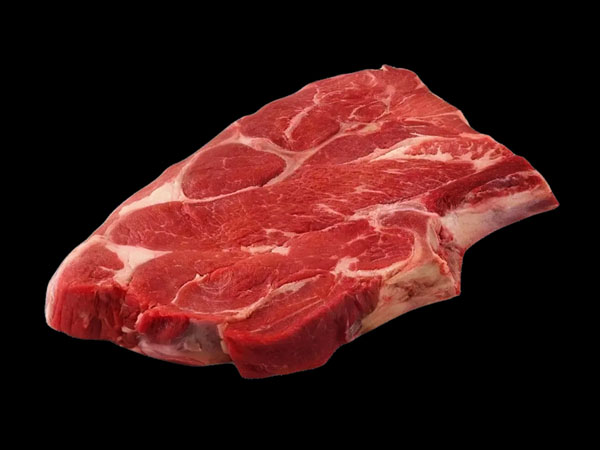
7-Bone Chuck Steak
The 7-bone chuck steak comes from the chuck primal of the cow and gets its name from the distinct bone shaped like the number 7. This cut includes multiple muscles and tends to be tough, but it offers a beefy flavor and is available at an affordable price. While it’s a naturally tough cut of beef, a good marinade or slow cooking works wonders to break down the connective tissue and tender the meat’s texture. Don’t overcook it. 7-Bone chuck steak will turn tough and chewy if left too long on the heat.
Other names: 7-Bone Steak, Bone-In, Bone-In Chuck Steak.
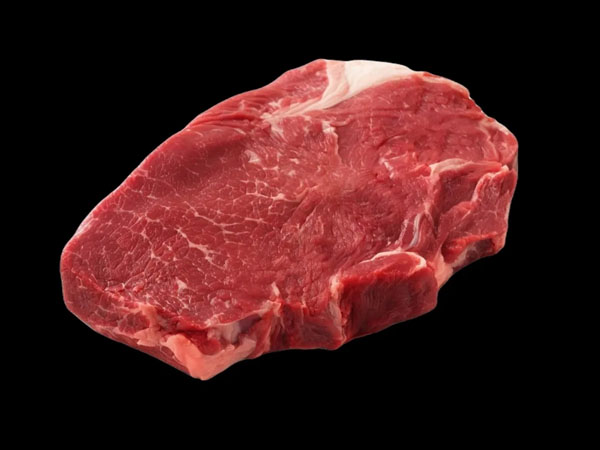
Chuck Steak
Chuck steak comes from the chuck primal of the cow. It’s a versatile cut with several muscles, including the spinalis dorsi and longissimus dorsi, prized for their tenderness and marbling. These muscles are more commonly associated with rib cuts, making chuck steak a flavorful and budget-friendly alternative to premium options like ribeye or strip steak. Depending on the specific cut, chuck steak has a rich, beefy flavor and is quite tender if cooked properly, though it does have more connective tissue and pockets of fat between the muscles. For best results, grill or pan-sear chuck steak over high heat.
Other names: Center Cut Chuck Steak, Chuck Center Steak.

Chuck Tender Steak
Chuck tender steak comes from the chuck primal, specifically the chuck tender sub-primal. Despite its name, this cut is very tough. Its shape resembles a filet mignon, but don’t let that fool you. A good marinade is essential to make it tender and enjoyable or opt for slow cooking methods like braising. Avoid high-heat cooking without tenderizing, as it will become overly tough and chewy.
Other names: Chuck Filet Steak, Chuck Tender Steak, Fish Steak.

Teres Major Steak
Teres major steak (mock tender) is a medium-sized, lean, yet surprisingly tender cut from the shoulder clod. While not as tender as filet mignon, it brings a more robust beef flavor. It’s best cooked to a maximum of medium-rare doneness to keep it tender and flavorful. Teres major (mock tender steak) size and leanness make it perfect for quick, high-heat cooking methods like grilling or pan-searing.
Other names: Mock Tender Steak, Shoulder Petite Tender, Chuck Shoulder Tender, Shoulder Tender, Teres Major Steak, Petite Tender Medallions, Bistro Steak, Teres Major Medallions.

Plate Primal

Hanger Steak
The hanger steak comes from the short plate primal of the cow, right at the front of the belly. It gets its name because it hangs from the cow’s diaphragm. It’s a big piece of meat, lean yet tender and full of strong beefy flavor, especially when cooked and sliced correctly. Remember to cut the hanger steak against the grain after cooking to make it as tender as possible. Hanger steak has a nice, grainy texture that works well with marinades. It’s perfect for pan-searing or grilling, but grilling is the way to go if you’re marinating it.
Other names: Hanging Tender Steak, Hanging Tenderloin Steak, Butcher’s Steak, Butcher’s Cut, Bistro Steak.

Inside Skirt Steak
Inside skirt steak comes from the plate primal of the cow, specifically the transversus abdominis muscle. It’s got a really good beefy taste and is low-to moderately tender if you slice it against the grain. Inside skirt steak cut is super versatile – you can cook it just like a regular steak or slice it thin for various recipes. Because it’s so thin, the best way to cook it is using direct heat on the grill, especially if you’re marinating it. You can also pan-sear it, but be careful – it’s easy to overcook it because it’s so thin.
Other names: Arrachera, Fajita Meat, Fajita Steak, Skirt Steak.
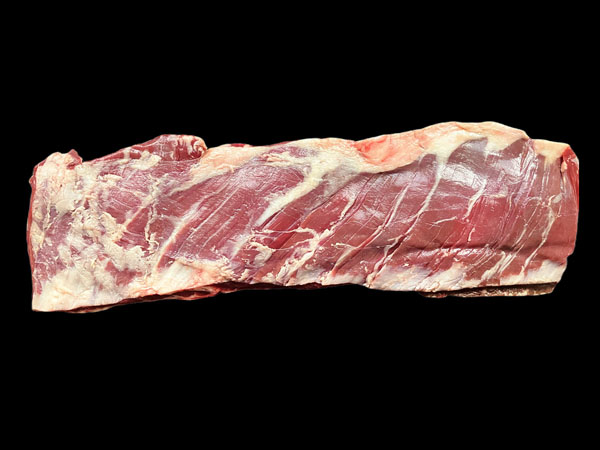
Outside Skirt Steak
Outside skirt steak comes from the diaphragm muscle, part of the cow’s plate primal. It’s different from the inside skirt steak; it’s longer but narrower, thinner, and has more fat. This skirt steak has a rich, beefy flavor and gets really tender if you slice it against the grain. An outside skirt steak is just a better version of a skirt steak. Since it’s pretty thin, cooking it fast on high heat works best. Grilling is ideal to get that nice crust, especially if you’re aiming for medium-rare.
Other names: Arrachera, Fajita Meat, Fajita Steak, Skirt Steak.

Flank Primal

Flank Steak
Flank steak is a lean, flavorful cut of beef that comes from the abdominal muscles of the cow. Though naturally tougher, it becomes tender when cooked properly and sliced thinly against the grain. This steak is ideal for marinating, as it absorbs flavors beautifully. It weighs 2–4 pounds and is perfect for serving a crowd. For best results, grill or sear over high heat for a quick, flavorful crust, aiming for medium-rare. Don’t forget to slice cooked flank steak against the grain to maximize the tenderness.
Other names: Beef Flank, Flank Steak Filet, Jiffy Steak, Plank Steak, London Broil.

Round Primal
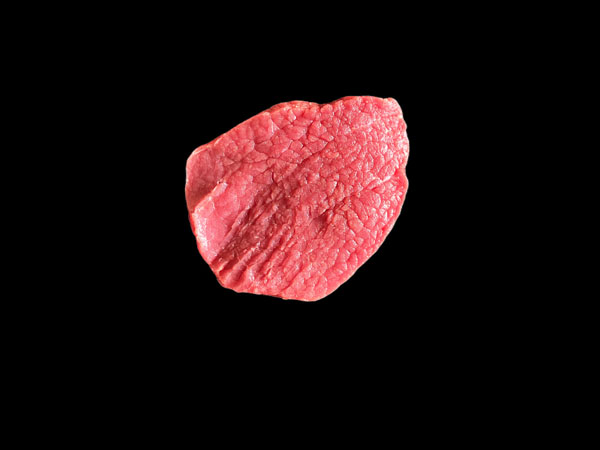
Eye of Round Steak
The eye of round steak is a lean, boneless cut from the cow’s rear leg, specifically the eye of round roast. It has a mild beefy flavor and is affordable, but unfortunately, it’s one of the toughest cuts of steak. Never cook the eye of round steak like a regular steak without tenderizing it first. It’s not great for quick, high-heat cooking, but its strong, rich flavor makes it perfect for slow-cooking methods. Braising, slow roasting, or using it in stews can make this cut tender and delicious.
Other names: Breakfast Steak, Sandwich Steak, Wafer Steak, Round Steak, Beef Round Steak Boneless, Beef Round Eye Steak.

Bottom Round Steak
Bottom round steak is a lean and budget-friendly cut of beef that comes from the bottom round roast in the cow’s round primal. Known for its toughness, it’s not as tender as other cuts but has a nice, beefy flavor when cooked correctly. This steak shines in recipes that require slow cooking, like braising, which helps break down its toughness. Quick, high-heat cooking isn’t a great idea unless you marinate the steak first. Using a marinade with natural enzymes from citrus, pineapple, or papaya can make a big difference by tenderizing the meat and making it more enjoyable to cook and eat. It is a great tip for tenderizing tough cuts of steak, not just the bottom round.
Other names: Western Griller, Bottom Round London Broil.
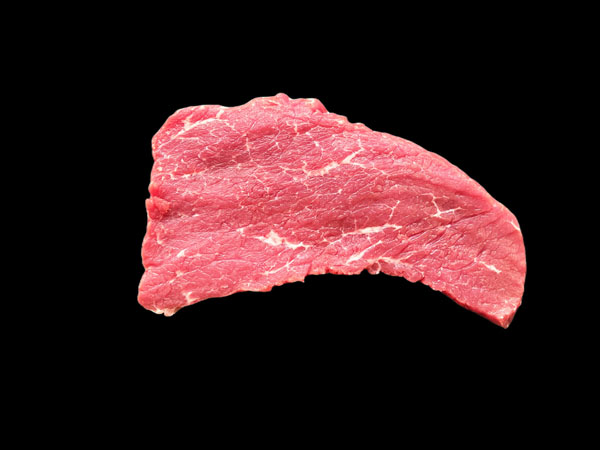
Top Round Steak
Top round steak is a lean and budget-friendly cut from the round primal section of a cow, specifically the top round roast. While it lacks the marbling of cuts like strip steak, it has a decent beefy flavor. Never cook top round steak like a traditional steak without marinating it first, as this will result in a tough and chewy texture. This cut needs extra care to shine. Top round steak is tougher than most others, making it ideal for slow, low-heat cooking methods like braising or roasting to break down the muscle fibers.
Other names: Inside Round Steak, Top Round London Broil, Top Round Steak Cap Of, Top Round Steak Cap On, Top Round Steak Center Cut, Top Round Steak Boneless, Butterball Steak.

Merlot Steak
Merlot steak comes from the heel muscle of the beef round, located just above the shank and below the bottom round. This cut is lean yet surprisingly tender, with a beefy flavor. Known as a hidden gem, it’s affordable and often only available through specialty butchers. Its shape and thickness resemble a flank steak, but its finer grain makes it more tender than a flank. For the best results, cook merlot steak no more than medium-rare and always slice against the grain to maximize tenderness.
Other names: Heel Muscle, Heel of Round Steak, Round Heel Steak, Butcher’s Steak.
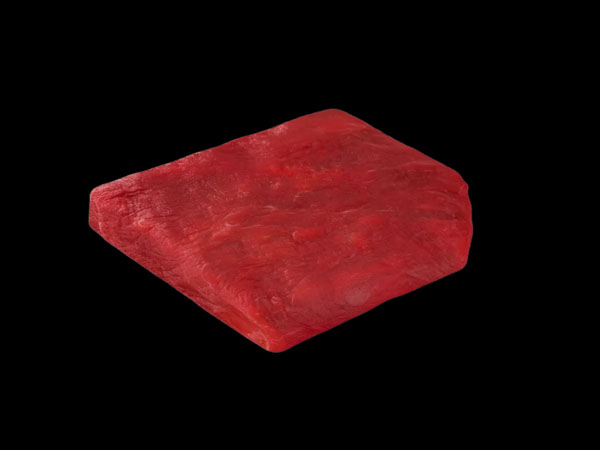
Santa Fe Steak
Santa fe steak comes from the cap of the top inside round. It’s a lean cut with a chewy texture, but it can be surprisingly tender and flavorful when cooked correctly. The cap is more tender and flavorful than the rest of the top round. This cut works great with a good marinade since it soaks up flavors well. The best way to cook santa fe steak is hot and fast, like a skirt or flank steak. Give it a quick sear, then slice it thinly against the grain to maximize tenderness.
Other names: Top Round Cap Steak, Top (Inside) Round Cap Steak.

Oyster Steak
Oyster steak (spider steak) is a rare and unique cut from the cow’s hip bone. Its name comes from the web-like marbling of fat that runs across the meat, resembling a spider’s web. Oyster steak is a small but tender cut with a rich, beefy flavor, making it a hidden gem for steak enthusiasts. Since it’s small, it’s perfect for quick cooking. The best way to cook oyster steak is by pan-searing or grilling over high heat until medium-rare.
Other names: Spider Steak, Butcher’s Steak.

Sirloin Tip Steak
Sirloin tip steak is a very lean cut from the sirloin tip subprimal, part of the round primal. It’s naturally a very tough cut of beef but shines in its affordability and versatility. Unlike tender cuts of steak, it’s not ideal for high-heat cooking. Sirloin tip steak has a beefy flavor that pairs beautifully with marinades, which help break down its toughness and enhance taste. Sirloin tip steak is perfect for kabobs, stews, or cubed steak recipes. For best results, marinate it and cook it low and slow for tenderness.
Other names: Breakfast Steak, Knuckle Steak, Round Tip Steak, Sandwich Steak, Tip Steak.

Sirloin Tip Center Steak
The sirloin tip center steak comes from the sirloin tip center roast, part of the round primal. It’s the most tender piece from the tip roast, but it still needs some love to bring out its best. This steak has a lean profile and a decent beefy flavor. Its affordability makes it a great option for budget-conscious steak lovers. To get the best out of this cut, marinate it well before cooking on high heat, or opt for slow cooking to ensure it will be tender and flavorful.
Other names: Breakfast Steak, Knuckle Steak, Round Tip Center Steak, Sandwich Steak, Tip Steak, Cap-Off, Trimmed Tip Steak.

Sirloin Tip Side Steak
Sirloin tip side steak is a lean, tough, and chewy cut from the sirloin tip side roast, part of the round primal. It’s an affordable, budget-friendly option often sold as thinly sliced sandwich steaks. While it’s not naturally tender, marinating it can help add flavor and tenderize it, especially if you’re cooking it over high heat. Slow cooking is another great way to break down its toughness and make eating more enjoyable.
Other names: Breakfast Steak, Sandwich Steak, Round Sirloin Tip Side Seak.
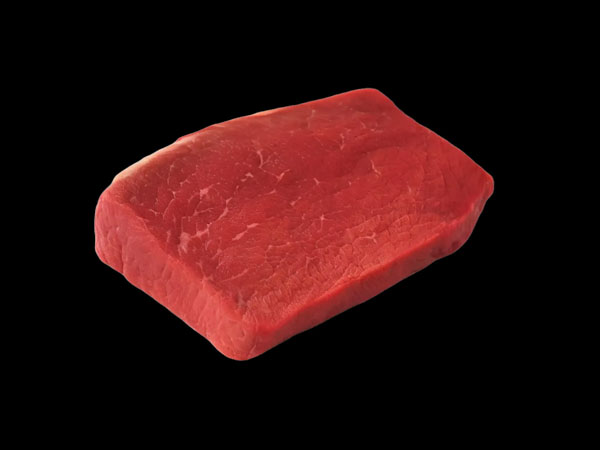
Western Steak
Western steak, a type of bottom round steak, is a lean and affordable cut from the cow’s round primal. It’s butchered slightly differently but still has the same tough and chewy texture but and beefy flavor you’d expect from the bottom round. It’s not naturally tender, but the flavor is worth the effort if you cook it correctly. Western steak is best suited for slow-cooking methods like braising, which tenderize its tougher fibers and enrich the flavor. If you prefer quicker cooking, marinate it beforehand to break down the meat’s toughness. A marinade with citrus or pineapple does wonders, tenderizing the western steak and turning it into a moderately tender, flavorful dish.
Other names: Bottom Round Steak, Western Griller.
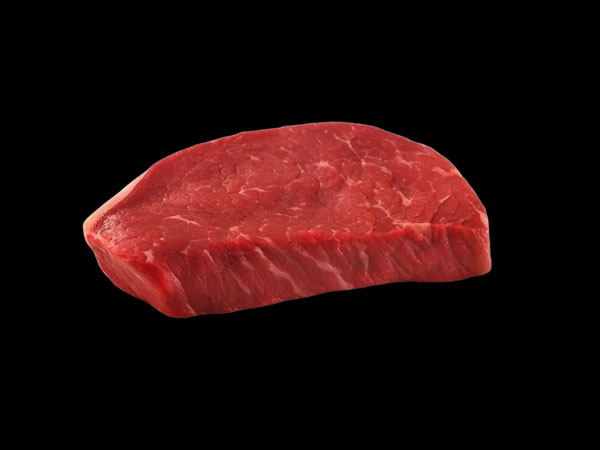
Western Tip Steak
Western tip steak comes from the sirloin end of the bottom round roast and is cut against the muscle grain into ¾ to 1-inch thick slices. This lean steak is a budget-friendly option, perfect for those seeking an affordable cut of beef with a decent flavor. Unfortunately, western tip steak is naturally tough and chewy, so cooking it like a regular steak without proper marinating first is not a good idea. The best way to cook western tip steak is to marinate it first, then grill or pan-sear it to rare or medium-rare. You can also consider slow-cooking methods to make it tender and flavorful.
Other names: Bottom Round Steak, Western Griller.

Ingredient Cuts
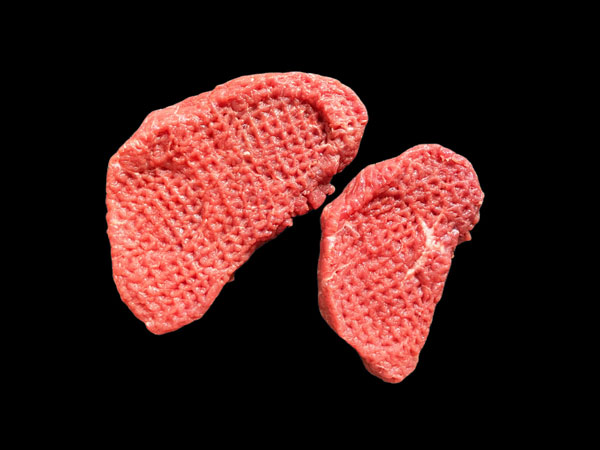
Cube Steak
Cube steak is an affordable cut of beef that’s been tenderized with a meat mallet or a mechanical tenderizer, giving it distinctive marks. It’s made from tougher cuts like the round or chuck primal, but the tenderizing process makes it more tender and easier to cook. The flavor can vary depending on the cut, but most cube steak tastes strongly beefy. The best way to cook cube steak is over high heat to medium-rare doneness or slowly with cooking methods like braising, which makes it tender, juicy, and flavorful. It’s versatile and great for dishes like chicken-fried steak, swiss steak, or even slow-cooked with onions.
Other names: Chicken Fried Steak, Cubed Steak, Minute Steak, Swiss Steak.

Sizzle Steak
Sizzle steak is a thinly sliced cut of beef, typically from the top sirloin or top round, with a thickness of about 1/4 to 1/2 inch (0.635 to 1.27 cm). This steak is known for its quick cooking time, making it a favorite for fast, easy meals. Sizzle steak is lean and flavorful, offering great value for budget cooks. It’s perfect for sandwiches, fajitas, stir-fries, or salads. Because it’s so thin, sizzle steak is perfect for high-heat cooking methods like pan-searing or grilling. Aim for medium-rare to keep it tender and juicy, and be careful not to overcook it.
Other names: Minute Steak, Sandwich Steak, Chip Steak, Philly Steak.

Minute Steak
Minute steak is a thin, boneless cut of beef, usually from the sirloin or round. Known for its affordability and versatility, it’s a great choice for quick, easy meals. Despite being lean, it has a decent beefy flavor but has a chewy and tough texture if not cooked correctly. The best way to cook a minute steak is to sear it over high heat for a short time, just 30-60 seconds per side. It’s perfect for steak sandwiches, stir-fries, or with a simple sauce. Be careful not to overcook it, or you’ll lose the flavor and juiciness.
Other names: Sandwich Steak, Breakfast Steak, Cube Steak.
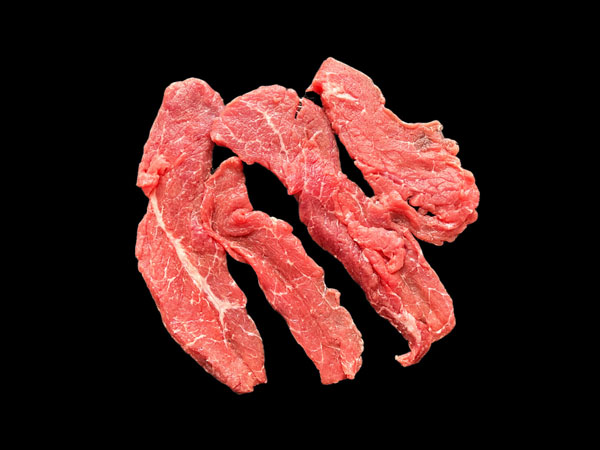
Chip Steak
Chip steak is an ultra-thinly sliced cut of beef, usually made by freezing the meat and slicing it paper-thin. Typically taken from the round, chuck, or sirloin, chip steak is known for its affordability and versatility. Its thinness makes it cook incredibly fast – on a hot surface in just a minute or two. Chip steak is perfect for cheesesteak sandwiches, stir-fries, tacos, or even as a protein boost in salads. Despite being cut from less premium beef, the thin slicing ensures a tender bite every time. The best way to cook chip steak is to sear it quickly over high heat in a hot skillet or grill.
Other names: Sizzle Steak, Minute Steak, Sandwich Steak.
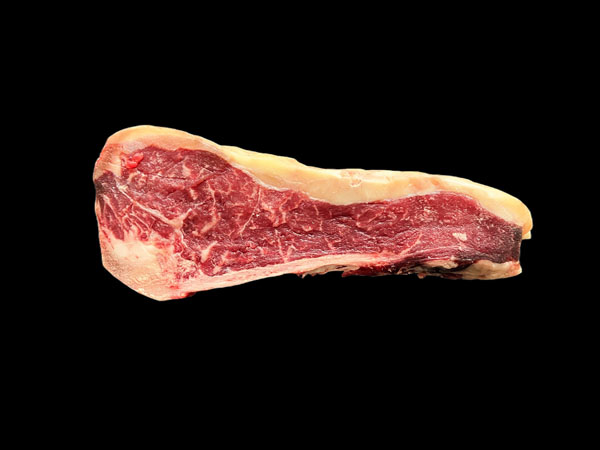
Club Steak
The term “club steak” refers to different cuts depending on the region, but it most commonly describes a smaller bone-in steak from the short loin, such as a portion of the strip steak or rib steak. No matter the cut, club steak is known for its tender texture and rich beefy flavor, with a small bone adding a rustic, classic appearance. The name has a few origin stories. Some say it’s tied to fancy private clubs, while others connect it to Delmonico’s restaurant in New York. The best way to cook a club steak is by grilling or pan-searing to medium-rare, which brings out its natural juiciness, tenderness, and rich flavor.
Other names: Bone-in Ribeye Steak, Bone-in Strip Steak, Bone-in Club Steak.

Delmonico Steak
Delmonico steak is a term that originates from Delmonico’s, a historic New York City steakhouse, and is associated with luxurious, thick-cut steaks. The exact cut varies, but it’s typically a ribeye, chuck eye, or strip steak. What defines a Delmonico steak is its generous size, rich marbling, and tender, juicy texture. The best way to cook a delmonico steak is by pan-searing or grilling.
Other names: Boneless Chuck Filet Steak, Delmonico.

Arrachera Steak
Arrachera steak is the Mexican name for skirt steak. This long, thin cut comes from the cow’s diaphragm and is popular in dishes like tacos, fajitas, and burritos. It’s thin and packed with rich flavor, but it can be a bit chewy if not cooked right. The best way to cook arrachera is on a hot grill or skillet, searing it quickly over high heat to medium rare. Always slice it thinly against the grain to keep it tender, making it perfect for any Mexican-inspired meal.
Other names: Skirt Steak.



